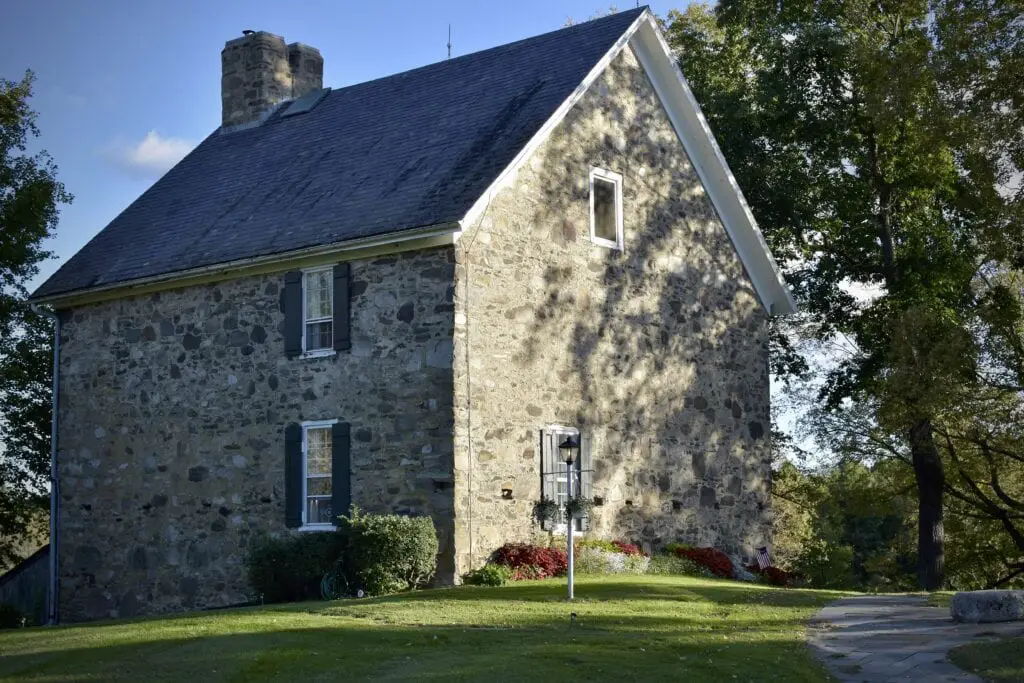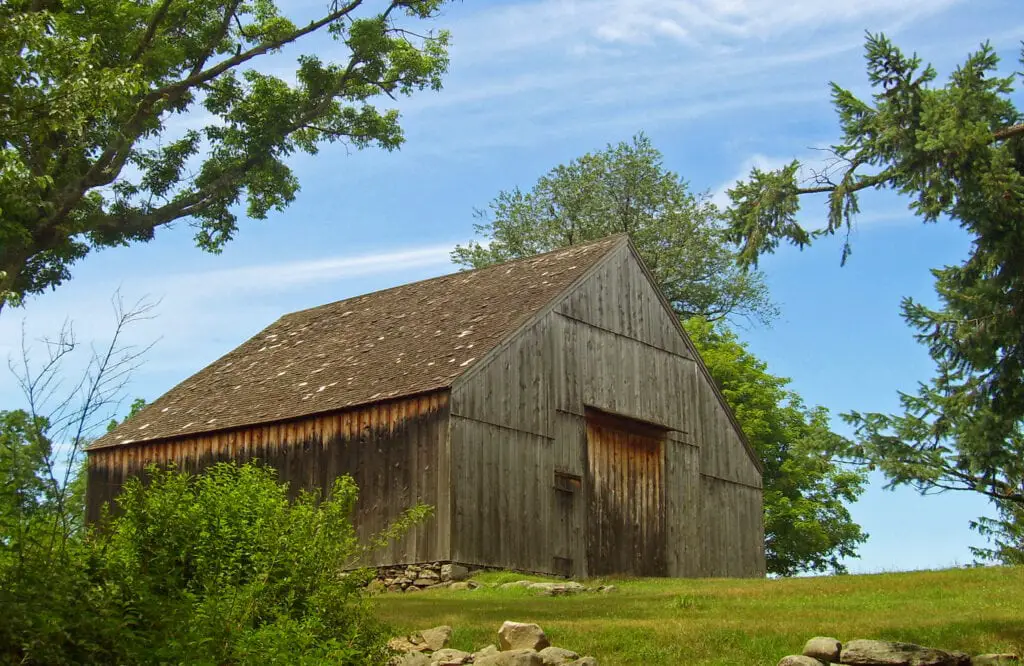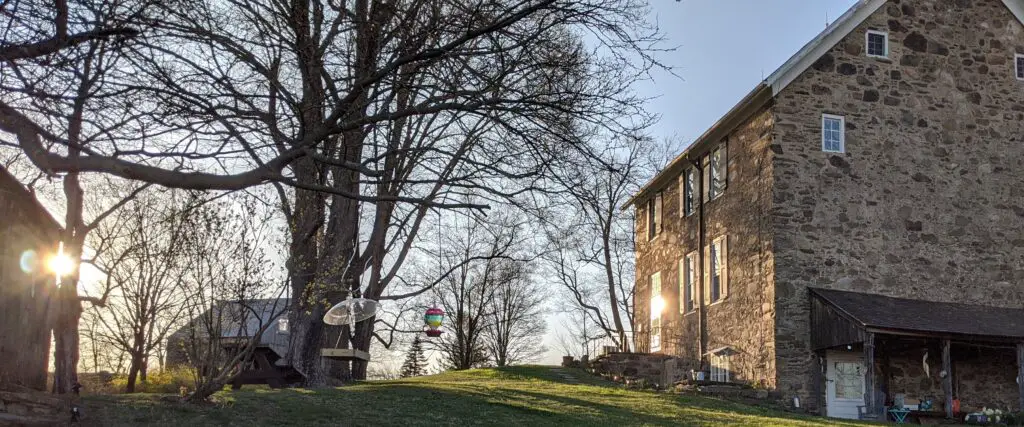The Historical Edifice of Bull Stone House
Nestled in the lush landscape of Hamptonburgh, New York, the Bull Stone House stands as a monumental testament to early American settlers’ architectural ingenuity and resilience.
Constructed in the 1720s, this ten-room stone house was not merely a dwelling but a fortress of heritage, meticulously crafted by William Bull, a master stonemason, and his wife, Sarah Wells. The house’s robust structure, with walls two feet thick, has withstood the test of time, encapsulating over three centuries of history within its sturdy confines.
The construction of the Bull Stone House was a labor of love and determination. The couple embarked on this ambitious project shortly after their marriage in 1718, marking the beginning of a new era in the Wawayanda Patent.
William Bull meticulously cut and laid each stone using his expertise as a stonemason. Embodying the pioneer spirit, Sarah Wells carried stones to the site, their combined efforts laying the foundation for a historic landmark.
The house’s completion in 1733, after a challenging thirteen-year construction period that even survived a 1727 earthquake, is a testament to the couple’s resilience and commitment.
Today, the Bull Stone House is a symbol of architectural prowess but also a centerpiece of cultural heritage in Orange County. The house, listed on the National Register of Historic Places since 1974, offers a unique glimpse into the life of the 18th-century settlers.
Its preservation and continued occupancy by the descendants of William Bull and Sarah Wells add a living dimension to its historical significance.
The Bull Stone House is a destination for those interested in colonial history, offering things to do north of New York City for history enthusiasts and casual visitors alike.
Its legacy, etched in stone and time, continues to inspire and educate, making the Bull Stone House a cherished landmark in the tapestry of American history.
William Bull and Sarah Wells: The Pioneering Couple
William Bull’s journey from Wolverhampton, Staffordshire, England, to the New World in 1715 marked the beginning of a remarkable chapter in the history of Central Orange County.
His skills as a stonemason quickly garnered the attention of prominent figures, including Daniel Crommelin, a prosperous New York City merchant and French immigrant.
Crommelin, recognizing Bull’s craftsmanship, employed him to work on the expansive Wawayanda Patent. This significant land grant encompassed much of the present-day towns of Goshen, Hamptonburgh, Minisink, and Warwick.
Sarah Wells’ story is equally compelling. Arriving in the New World as an indentured servant at sixteen, she displayed an unparalleled tenacity and survival instinct.
Her journey with Christopher Denne, her master, from a townhouse on Pearl Street in New York City to the untamed wilderness of the Wawayanda Patent is a testament to her courage and resilience.
Sarah’s adeptness and resourcefulness quickly made her an integral part of the burgeoning community, eventually leading her to cross paths with William Bull.
The union of William Bull and Sarah Wells in 1718 was not just a marital alliance but a partnership that laid the groundwork for the region’s development.
Their marriage, the first recorded between European settlers in Goshen, symbolized the merging of skills, cultures, and aspirations, setting the stage for constructing the Bull Stone House and the subsequent growth of their family and community.

A Legacy Cemented in Stone: The Bull Family’s Historical Impact
William Bull and Sarah Wells’ legacy extended far beyond the confines of their stone house. Their twelve children, who all reached adulthood and established their own families, became pivotal figures in the region, contributing to the social, economic, and cultural fabric of Central Orange County.
The Bull family’s influence was so profound that it left an indelible mark on the area, with several landmarks bearing their name.
The hamlet of Bullville and the Thomas Bull Memorial Park are enduring tributes to the family’s prominence and their contributions to the community.
These sites honor the memory of the Bull family and serve as tangible links to the region’s past, offering residents and visitors alike a glimpse into the area’s rich history.
Moreover, the houses of Thomas and William III Bull, listed on the National Register of Historic Places, further exemplify the family’s architectural legacy and commitment to the community’s development.
These structures, along with the Bull Stone House, form a historical constellation that narrates the story of a family whose influence shaped the destiny of Central Orange County.
The Bull Stone House: A Living Museum
The Bull Stone House, a historical preservation beacon, continues captivating visitors as a living museum. Its inclusion in the National Register of Historic Places 1974 underscores its architectural and historical significance.
The house, meticulously preserved by the William Bull and Sarah Wells Stone House Association, offers a tangible connection to the early 18th century, providing insights into the lives of its original inhabitants and the broader colonial era.
The association, formed in 1920, has been instrumental in maintaining the integrity and authenticity of the Bull Stone House. Through their dedicated efforts, the house has been preserved as a monument and as a home, continuously occupied by the descendants of William Bull and Sarah Wells.
This unique aspect adds a dynamic layer to the house’s history, making it a living testament to the family’s enduring legacy.
In addition to its historical significance, the Bull Stone House is an educational resource. The association organizes tours, allowing the public to step back in time and experience the rich tapestry of American colonial history.
These tours, led by knowledgeable guides, offer an immersive experience. They highlight the households’ architectural features, historical artifacts, and fascinating stories.

The Annual Bull Family Reunion: A Tradition of Togetherness
The Bull Stone House symbolizes historical preservation and is a focal point for family heritage. Since 1867, it has hosted the Bull Family Reunion and Picnic, marking it the second-longest annual family reunion in the United States.
This storied event, spanning over a century and a half, is a testament to the Bull family’s strong familial bonds and shared heritage.
The reunion, traditionally held on the grounds of the Bull Stone House, attracts descendants from across the country and beyond.
It’s a vibrant gathering that celebrates the family’s lineage with activities, storytelling, and communal meals, fostering a sense of belonging and continuity among the attendees.
The event not only honors the legacy of William Bull and Sarah Wells but also reinforces the connections between the present and past generations of the Bull family.
In recent years, the reunion has adapted to changing times. In 2020, the family showcased their resilience and unity by organizing a virtual gathering in response to the global pandemic.
This innovative approach ensured that the tradition continued, underscoring the family’s commitment to maintaining their bonds and heritage, regardless of the challenges faced.
The Bull Family Reunion is a vibrant celebration of heritage, unity, and the enduring legacy of the Bull Stone House.

The New World Dutch Barn: A Rare Architectural Gem
Adjacent to the Bull Stone House stands a remarkable structure, the New World Dutch Barn, a rare architectural gem that further enriches the property’s historical landscape.
This barn, the only example of its kind in Orange County, is a testament to the early settlers’ agricultural heritage and architectural ingenuity.
Its unique design and construction techniques offer a glimpse into the farming practices and rural life of the 18th century.
The Dutch Barn, characterized by its broad, gabled roof and large, open interior space, was designed to meet the specific needs of the early Dutch settlers in the region. Its structure, optimized for storage and threshing of grains, reflects the agricultural priorities of the time.
The preservation of this barn, alongside the Bull Stone House, provides a comprehensive view of the living and working conditions of the early settlers.
The significance of the New World Dutch Barn extends beyond its architectural features. It represents the cultural and economic life of the region, serving as a reminder of the settlers’ relationship with the land and their resourcefulness.
The barn’s preservation, like that of the Bull Stone House, is a tribute to the commitment of the William Bull and Sarah Wells Stone House Association and the broader community to safeguarding their local heritage.

The Bull Stone House in Modern Times: Preservation and Public Engagement
In the modern era, the Bull Stone House has embraced its role as a custodian of history, engaging the public and ensuring the preservation of its legacy.
The efforts of the William Bull and Sarah Wells Stone House Association have been pivotal in this endeavor, transforming the house from a private residence into a beacon of historical education and community engagement.
The association’s commitment to preserving the house’s authenticity and integrity has made it a valuable educational resource.
The introduction of guided tours and educational programs has opened the doors of the Bull Stone House to students, historians, and curious visitors, allowing them to immerse themselves in the rich tapestry of colonial history.
These initiatives highlight the house’s architectural and historical significance and foster a deeper understanding and appreciation of the region’s heritage.
Furthermore, the Bull Stone House’s participation in initiatives like the Blue Star Museums program exemplifies its commitment to community engagement.
By offering free admission to military personnel and their families, the house honors those who serve while providing an opportunity for a wide audience to connect with the nation’s history.
This inclusive approach ensures that the legacy of the Bull Stone House and the stories it holds continue to inspire and educate future generations.
